06.21.20
Posted in Family, Hacking, Married life, programmer productivity, Technology trends at 11:07 am by ducky
After waiting literally decades for the right to-do list manager, I finally broke down and am writing one myself, provisionally called Finilo*. I have no idea how to monetize it, but I don’t care. I am semi-retired and I want it.
I now have a prototype which has the barest, barest feature set and already it has changed my life. In particular, to my surprise, my house has never been cleaner!
Before, there were three options:
- Do a major clean every N days. This is boring, tedious, tiring, and doesn’t take into account that some things need to be cleaned often and some very infrequently. I don’t need to clean the windows very often, but I need to vacuum the kitchen every few days.
- Clean something when I notice that it is dirty. This means that stuff doesn’t get clean until it’s already on the edge of gross.
- Hire someone to clean every N days. This means that someone else gets the boring, tedious, tiring work, but it’s a chore to find and hire someone, you have to arrange for them to be in your space and be somewhat disruptive, and of course it costs money.
Now, with Finilo, it is easy to set up repeating tasks at different tempos. I have Finilo tell me every 12 days to clean the guest-bathroom toilet, every 6 days to vacuum the foyer, every 300 to clean the master bedroom windows, etc.
Because Finilo encourages me to make many small tasks, each of the tasks feels easy to do. I don’t avoid the tasks because they are gross or because the task is daunting. Not only that, but because I now do tasks regularly, I don’t need to do a hyper-meticulous job on any given task. I can do a relatively low-effort job and that’s good enough. If I missed a spot today, enh, I’ll get it next time.
This means that now, vacuuming the foyer or cleaning the toilet is a break — an opportunity to get up from my desk and move around a little — instead of something to avoid. This is much better for my productivity instead of checking Twitter and ratholing for hours. (I realize that if you are not working from home, you can’t go vacuum the foyer after finishing something, but right now, many people are working from home.)
It helps that I told Finilo how long it takes to do each chore. I can decide that I want to take a N minute break, and look at Finilo to see what I task I can do in under that time. It does mean that I ran around with a stopwatch for a few weeks as I did chores, but it was totally worth it. (Cleaning the toilet only takes six minutes. Who knew?)
And this, like I said, is with a really, really early version of Finilo. It’s got a crappy, ugly user interface, it breaks often, I can’t share tasks with my spouse, it’s not smart enough yet to tell me when I am taking on more than I can expect to do in a day, there’s not a mobile version, etc. etc. etc… and I still love it!
*Finilo is an Esperanto word meaning “tool for finishing”.
Permalink
05.22.11
Posted in Canadian life, Family at 7:36 pm by ducky
Note: Dion, my instructor read this and was concerned that it painted an overly negative, overly scary picture of the sport. I toned my language down slightly, but my main objective was to tell my family and friends about how I felt, not to evangelize for how fun (or safe) the sport is!. Paragliding is actually quite safe when done right; my next post will be on paragliding safety.
My husband Jim flies powered aircraft; I find flying in small planes dull, noisy, cold, and a waste of fossil fuel. Jim sings; I don’t. Jim runs; I have bad knees. I do artwork; Jim doesn’t. I like to skate; Jim doesn’t. I like to read and write, which are inherently solitary activities. From time to time, one of us will try to do something that the other likes: I sang in one opera; Jim has gone skating a few times; Jim and I took a sketching class together; I have flown in small planes with Jim a few times. Unfortunately, those efforts have not worked really well. (For example, I threw up on one of my small plane rides with Jim.) Despite us really liking each other, we don’t do much together.
When we were in Turkey with the nephews, I got a chance to take a ride in a tandem paraglider. Despite throwing up twice due to motion sickness (I am sensitive, and didn’t take meds in time), it was one of the high points of the trip for me. (Figuratively as well as literally.) So I seized on paragliding as something we could maybe enjoy together.
We signed up for and are now mostly done with the P1 introductory class at iParaglide. In the rest of this post, I’m going to talk about our experiences.
We started out with two theory classes. We learned intellectually what we were supposed to do on launch and landing, about the gear, a little on the aerodynamics of the wings, how the controls affected the wing, how wind strength and weight affected ground speed and sink rate (which are the components of the glide ratio), and a bit about weather in BC.
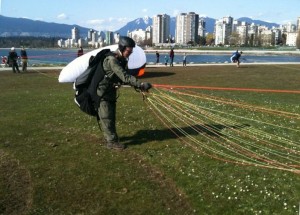
Jim preparing to do a reverse launch kite; our apartment tower is in the background.
We next had a gratis session of kiting practice. (This wasn’t on the class agenda, but Dion Vuk, our instructor, said that the weather was great for it and it would make us better fliers.) Kiting is done on a flat piece of ground and the exercise is to get the glider (aka “the wing”) aloft over our heads for as long as we could.
It was difficult, and hard work for my out-of-shape 47 year-old body. I was exhausted at the end of it. I said to myself that my enjoyment of this sport would be lower if I didn’t get myself into better shape, so I started carrying water in my backpack on my walk to work. Four or five days per week, I would walk 3km to work carrying five litres of water in my backpack; two or three days per week I would also walk home with it. If there had been an earthquake, I would have been prepared!
The day after our kiting session, the class of about seven students practiced what is called “slope soaring”. We got up at 5 AM to go out to a city park about an hour away which has about a 30′ hill. That hill is just steep enough that you can launch off of it, but not steep enough that you can get very high above it.

Jim catching air at slope soaring
The wing needs a relative airspeed of 20 km/hr (12.5 mph, or 4:48 minutes per mile). This would be really really hard on a flat surface with no headwind if your name isn’t Usain Bolt, but running downhill with a little bit of a headwind (which drops the groundspeed you have to achieve) makes it more possible. It is still a little bit of a challenge: when the wing isn’t fully up, it’s like you are pulling a parachute — because you are! As soon as the wing gets up, it is easier, but if you don’t haul posterior, worst case the wing’s momentum can bring it over and in front of you and you run into the wing, oops. More likely is that you run run run and just don’t get enough speed to lift off the ground, which is unsatisfying.
There is no jumping: if you jump up, that reduces your airspeed and you just come right back down. (Hubby Jim also points out that it reduces tension in the lines, which is counterproductive: the tension in the lines is part of what gives it the shape you need.)
The weather that day was suboptimal: the winds were coming from the west instead of the east, which meant we needed to launch from a less-optimal hill; it was a bit gusty, so hard to keep the wing from rolling off to one side. Because the weather was worse than forecast, Dion decided to not take us up to the mountain that same day, but to give us another morning of slope soaring. I was glad, because I was wiped out. (See above about being 47 years old.)
Thus the next day, we got up at 5 AM to get to the park at 6 AM, for another three hours or so of slope soaring. It was much easier due to much better winds, and we had fun running up and down the hill in a friendly competition to see whic pair of people could get the most flights-with-air in a specified time. (Note: it is really helpful to have a “buddy” when learning. Once you are clipped in to your harness, you are connected to your wing so can’t do a good job of laying the wing out by hand if the wind moves it. We were taught how to better adjust our wing on the ground using our lines, but it is helpful to have an extra pair of hands. We were paired with a buddy in kiting and slope soaring.)
We then drove 2 hrs up to the mountain site, walked around the Landing Zone (LZ), and then went to lunch. The weather in the Lower Mainland of BC is such that almost always, the winds will pick up significantly at mid-day, too much for novices to handle. We pretty much can’t fly between 1300h and 1700h, so lunch tends to be from 1400h-1600h or so (with the rest of the time spent packing or unpacking and getting up from or down to the restaurant).
After lunch, Dion (slowly and deliberately) launched the students, one by one. The winds died down as the day progressed, so Dion launched the students in reverse order of weight, which put me in the penultimate spot.
A note: I ? Dion. Dion is extremely safety conscious, attentive, and supportive. Not only did he give Jim and I kiting practice plus two days of slope soaring practice before the Big Launch, he spent a long time with each student on launch to make sure that they had a good launch: checking the lines (the cables that attach to the glider), checking our harness (the thing that attaches us to the lines), laying out the glider so that it would be maximally easy to launch, reassuring us, etc. All of Dion’s students had perfect launches the first time that day; this was not true of all the student pilots with other teachers.
I had a totally unremarkable launch and then… I was in the air! “Was it cool? Were you excited?” I hear you ask. Well, yes and no. Mostly I was focusing on not killing myself; following Dion’s instructions on the radios (we each had radios clipped to our harness; two for redundancy) to sit back in the harness, do a left turn, a right turn, a 180, etc. as he made sure that I had some modicum of competency. Next, I was focusing on aiming at my target: three tall trees at the far, upwind side of the LZ. I was distracted for a minute by some bumps in the ride: I apparently had gone through a thermal: one bump for going in, one bump for coming out.
The landing sequence goes like this: go to above the far, upwind corner of the LZ (a rectangular grassy field bounded by tall trees). Do one or more figure-8s along the short side (cross wind) to burn altitude; then turn and go downwind along the long axis of the field on the far (i.e. farther from the launch area) side of the field. At the other end of the field (“the base”), optionally burn some more altitude with one or more figure-8s; turn into the wind (to help slow the groundspeed); at the last minute, flare (i.e. stall the wing) to give a slight bit of lift and a lot of decrease in ground speed; run like hell to keep up with the glider as it comes down.
We were told to always always always turn towards the instructor, never ever away (which meant left turns for this landing spot); to “put our landing gear down” (i.e. stand up in the harness instead of sitting in it) halfway down the downwind leg; and to never ever ever make sharp turns close to the ground. I blew all three of those. The LZ instructor (who was new) had the practice of putting legs down much closer to the touchdown so didn’t tell me yet, and I didn’t remember to do it on my own. On the downwind leg, I misunderstood the LZ instructor telling me to ease up on my right brake as a request for a right turn, which confused me long enough that I didn’t turn left when I should have. That meant that I was closer to the trees in front of me than I liked, so I made a sharp turn (oops!) to the left.

"my" wing in the briars
Well. If you do sharp turns, you lose altitude fast, and suddenly I was on the ground. Also, because I had not turned in time to hit the nice part of the field, I landed in bunch of briars. I didn’t really panic because I didn’t have time. One minute I was heading for the trees, the next I knew the ground was really close, the next I was on the ground on my side in the midst of briars.
I thought to myself, “Am I damaged? Nope: successful landing!” And I really wasn’t: not a cut, not a scratch. Later I found what might have been two tiny little puncture wounds, each about the size of a small zit, but I might have easily gotten those during slope soaring.

My heroes!
My stomach felt awful, however. My stomach is already acid-sensitive, and it turns out that adrenaline dumps a lot of acid into the stomach. I didn’t know that, however, so thought I had gotten motion sick. “This sucks!”, I thought to myself. I really wanted this to be something Jim and I could do together, but if I am so sensitive that I will get this motion sick on my first fifteen-minute flight, that wasn’t good.
Given how concerned everyone else was by my well-being after “crash landing” in the briars, and how bad I felt, they let me lie around groaning while they untangled my wing from the briars for me. Thanks, peeps!
Interestingly, this landing did not make me more scared of flying, it made me less scared. I am an out-of-shape, not particularly coordinated 47-year-old who did three things that I had been explicitly warned not to do, had an uncontrolled landing into briars, and still was unscratched. There is more room for error in this sport than I had realized.
Jim and I debriefed, went home, and collapsed into bed. I was wiped out.
The next two weekends had nasty weather, so we didn’t fly.
Finally, a break in the weather. On Thursday, Dion offered another evening kiting session that we jumped on. (The kiting sessions are surprisingly fun.) While I had trouble getting the wing up, I was not completely exhausted. Let’s hear it for carrying five litres of water 3 km to work and back for three weeks!
We were scheduled to have class on Sat/Sun, but Thursday evening, after the kiting session, Dion looked at the weather and didn’t like what he saw. He called around to see who could come to a session on Friday, and managed to get a quorum. So we got up at 5AM on a Friday morning and drove out to the mountain.
One really big advantage of flying on Friday is that we had almost no company at the top of the mountain. I think there were only five other people there the whole day.

At the launch site, holding the bag the wing is stored in; you can see Mike setting up behind me.

Me starting to get up from a faceplant; LZ instructor coming to check on my health.
On my first flight of the day, I was a little bit more relaxed, and actually got to look around a little bit. However, I came in a little bit low and wasn’t able to make my turn onto final. Instead, I landed crosswind on the downwind short-side of the field. This meant that I didn’t get any help from a headwind to slow me down. I couldn’t run fast enough, so stumbled and fell face-first.
The great news was that I was again completely unhurt (again, not even a scratch, bruise, or scrape); the good news is that my stomach wasn’t nearly as upset as it had been after my close encounter with the briars; the bad news is that my stomach was still unhappy; the worse news is that I got motion sick on the bumpy drive up the rutted logging road. (The great news is that I did not get vomit all over the inside of Jeff’s vehicle!)
I was still feeling queasy when the time came for my next flight. Dion asked how I was feeling, I shook my head “no”, and he immediately scrubbed my flight with no recriminations of any kind. The man is extremely supportive.
(Jim and the other students flew, however, and had great fun. Dion had them ride thermals a little bit to get them used to soaring. One of the other students, Jeff, is really good at this, in part from experience kiteboarding, and he was aloft forrrreevvvvvverrrrr!)
Then we debriefed, had lunch, and went back up. We started flying again around 1700h, I believe. As I said before, the winds are high mid-day and get weaker, so Dion again sorted by decreasing weight, putting me at the end of the line. When it was just me and Dion at the top, the wind started being a bit erratic and I started getting nervous about the launch. I was also aware that everyone else was waiting for me at the bottom. Dion soothed me and calmed me down about the launch.
I was also a bit nervous about the landing. The stated objective of the last flight was to get us to land on our own. At this point, I have one landing in the briars and one near-face-plant… and that was with help. Zero fully correct landings (unlike the others, who have had two or three apiece by this time). Now I’m supposed to do it on my own?

That tiny speck in the center is me.
But Dion was right, the winds did die down. I tried to launch — and wasn’t going fast enough. I tried to abort, fell on my butt, and slid into my wing. Pick up, try again, wait… wait… wait… and finally, it was a go! I ran like hell down the slope and was airborne!
This time, everything felt smoother. I looked around more, and got to go “wow, I am way up in the air and can see all kinds of stuff!”. Eventually I got over the landing field and started my way down. First mistake: I did triangles instead of figure-8s to kill altitude on the upwind short side. No real harm done, but it meant that I ended up way over (inside) the field instead of sticking to the boundary. Next mistake: I forgot to put my landing gear down halfway through the downwind leg. Then, when I got to the base (downwind, short-side), I was a bit high.

On the base (downwind, short-side) leg
I did one loop of a figure 8 to kill some height, and started back towards the far side of the field. I dithered and dithered for an eternity (like, two seconds) about whether I should turn upwind or do another loop. I wasn’t sure if I had enough height to do another loop of the figure 8 or not, but felt like I was higher than I was supposed to be to land. I worried that if I was too low, then things would happen so quickly that the instructor (monitoring and on the radio to provide corrections if I got into trouble) might not be able to help me before I got in the trees, and that would be bad. The landing field is very long, so I figured that the instructor would have enough time to tell me how to recover if I was too high. I thus decided to go for “final” instead of another figure 8 loop.
I was too high to land in the first third of the field like they like us to. The orange spot in the lower left of the next photo is the target we were supposed to try to hit, and you can see I am way too high to hit that:
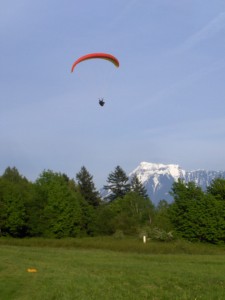
on final approach
As I came in, I flew over the heads of the other students, who gaped up at me. It became clear that I was in fact going to land well before the trees, which was a relief. The LZ instructor came on the radio and told me to put my landing gear down when I was about 30 feet off the ground, oops! Fortunately, it was easy to pop into a “starfish” stance from my sitting position.
But where should I flare? If you flare too high, then you fall from a height. If you flare too low, then you don’t lose enough speed and might get pulled by your glider (i.e. face plant). Fortunately, the instructor came on and told me to when to flare. I flared hard and got ready to run like the dickens:
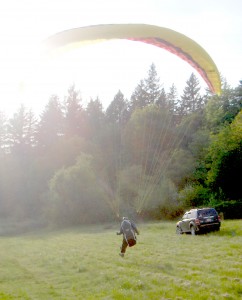
getting ready to sprint
I touched down very gently, took two, maybe three dainty little steps, and was, much to my surprise, stopped! Zero forward velocity, and my wing was just sitting above my head. It took 15 or 30 seconds to float to the ground as I just stood there with my mouth hanging open. In the following picture, I am not only stopped dead, I have started to turn around an look behind me at everybody else. You can if you look very closely that the lines to the right of me are slack and starting to collapse.

cold stop

~1(?) sec later
It was amazing. I literally could not have imagined — it was beyond my imagination — that it was possible for me to have a landing like that.
My stomach was not upset immediately, but it got unhappy a minute or two later. (Not as bad as the other times.) I immediately chewed two Tums, and that seemed to make it better.
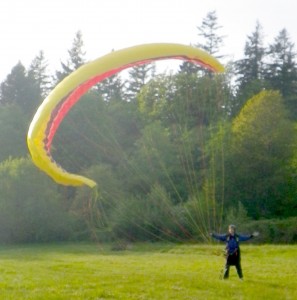
about 10(?) seconds after landing
We debriefed and went home. The next day, I was really lethargic and spent basically the whole day in bed. Note, however, that I was merely lethargic after one day of flying plus one evening of kiting (and two days of getting up way way early) instead of being totally wiped out after one day of either. Now if you will excuse me, I need to go carry six litres of water down to the beach!
Permalink
12.05.10
Posted in Family, Travel at 9:41 pm by ducky
As our most recent — and final — instalment of our rent-a-nephew program, we took two nephews to Turkey this summer.
Turkey was surprisingly difficult for us to travel in because we didn’t speak the language. I realize that that’s probably how it goes for most tourists, but we have generally been able to have *some* facility in the local language. Even when we went to Bali, we were able to learn some rudimentary grammar and vocabulary. This time, in part because Turkish is so hard for an Indo-European speaker and partly because we were *so* busy before the trip, we couldn’t really say more than “hello”.
Also because we were busy, we did essentially no planning ahead of time. Jim booked us a hotel for the first three nights in Istanbul, but aside from that, we had no itinerary. For the first two days, Jim and I discussed (with some input from the nephews) what we were going to do and how we were going to accomplish it. Note that “discuss” is a somewhat polite word.
Eventually, we admitted defeat and decided to throw ourselves on the mercy of a travel agent. We looked around on the Web for recommendations, and ended up going with Turista Travel. We walked in, told Davut who we were, what we were looking for, and he basically arranged everything.
The basic style of the trip he built for us was a sequence of mini-packages. “Package tour” had always sounded to me like “two weeks on a bus with 50 other rich old white Americans”, but that’s not the flavour of the trip. Instead, most days on the Turista-arranged tour went like this:
- Wake up at a decent, clean but not opulent hotel.
- Have breakfast at the hotel’s breakfast buffet (food included, drinks extra).
- Get picked up by a minivan that would carry a driver, a guide, and 2-6 other tourists, usually Europeans.
- Go to a cultural site, where the guide would show us around.
- Go to a banquet center (which our nephews quickly dubbed “Tourist Feeding Centers”) with (food included, drinks extra) with adequate but not super-tasty food and chairs with bows on the backs, filled with other rich white overweight tourists.
- Go to another cultural site, where the guide would show us around.
- Go back to the hotel *or* get sent on to the next hotel. Note that they arranged ALL the pickup / drop offs.
- Have dinner at the hotel’s buffet (food included, drinks extra).

A Tourist Feeding Center in Turkey
This was not always the exact schedule.
- Sometimes the guides would take us to a really yummy place for lunch. Lunch costs came out of their profit, but they allowed as how they could only handle so many meals at the Tourist Feeding Centers. Those meals were usually really, *really* good (as opposed to adequate at the TFCs).
- Sometimes the guides would take us to commercial artistic establishments where we would get demonstrations of how crafts (e.g. rugs, pottery) were made, and be given the opportunity to buy stuff. We believe the guide got a kickback for bringing customers to the factory, but the demos were generally pretty interesting, and the pressure wasn’t too bad to buy.
- We went on a four-day boat trip where the rhythm was to go to anchorages and swim instead of getting tours of cultural sites. (The boys loved that part; I was bored.) (Food included, drinks extra.)
By and large, the trip went very smoothly. It was not perfect:
- One day the minivan broke down going over the mountains, and we lost an hour or two while they arranged a different van for us.
- One day our package was subcontracted to a different vendor, but we didn’t know that, so at the pickup, we were looking for “Turista” and the driver was looking for people looking for “Beach”.
- One day, there was some confusion about which bus we took, when, and where the tickets were supposed to come from. The hotel’s English-speaker was on vacation, plus we didn’t realize we already had the tickets, etc.
However, in the first case, it wasn’t anybody’s fault, in the third case we were at least partially to blame, and in ALL cases, the staff worked hard to make it right. (When we got back to Istanbul, I stopped by the Turista office and Davut tried to refund our money for the bus ticket; I insisted that we only take half because it was partially our fault.)
We might have been able to do the trip cheaper ourselves, but it is more likely that it would have been more expensive if we had done it “a la carte”, and I am sure that we would have encountered more frustration and seen less if we had done it ourselves. I am pleased with Turista and would recommend them to all but the most experienced or frugal travellers.
We spent three days in Istanbul at the beginning of the trip and two or three at the end of the trip on our own, and did mosque and museum crawls which I found quite interesting. We also ate really, really well. The food in Turkey is really, really yummy in general.
The cultural sites were great from my point of view; the swimming was great from the boys’ point of view. My take on those is probably no more interesting or insightful than any other travelogue you can find on the Web for the most part. I will give you only a few points:
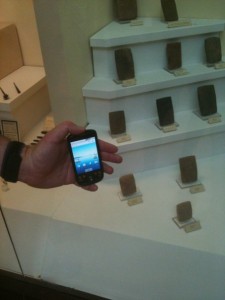
smartphone vs. cuneiform tablet
- We made a special effort to stop in the capital, Ankara. It’s not on the usual tourist route; apparently there’s not much there. However, they do have an amazing museum there that were quite interesting to someone interested in old writing systems. In particular, they had lots of cuneiform tablets. I had always thought of cuneiform tablets as being like the tablets that Moses is shown carrying in cartoons: about as tall as waist-to-chin; a bit wider than a torso. Well, to my surprise, they are about the size of iPhones, and the script is TINY. The script was made by pressing the ends of reeds into clay and the reeds were basically the size of small grass blades. I guess it makes sense: iPhones fit nicely in the hand, and one would probably want a cuneiform tablet to fit nicely in the hand.
- Also at that museum, I saw artwork that seemed to be between cave paintings and stylized Greek art. I found that fascinating: I had never seen quite that niche of art before.

Art between cave paintings and Greek urns
- As everyone else who has been to Turkey will tell you, the Turks are very very friendly, especially rug salesmen who want to show you their wares. However, something very interesting happened: they were on us like flies when we were in Istanbul at the start of the trip, but much less when we returned at the end of our trip! Someone suggested that we walked differently or gazed differently, but I don’t think that was it: I think we were pasty white at the start of the trip and suntanned at the end of the trip. So if you want less hassle from the rug vendors, catch some rays before you go.
Best anecdote of the trip: there was some commotion at a restaurant we were at. The woman at the table behind me was complaining loudly that she had complained three times “Excuse me, this is rubbish” to a busboy and said busboy did not bring the manager so she could complain about the food. (Excuse me, that’s HIGHLY colloquial English!) The manager (who eventually showed up) pointed out that the busboy didn’t speak English well. The woman then exclaimed, “How do you expect to serve the public if you can’t even speak the language???”
I was pleased that my nephews both immediately had to stifle laughter and also pleased that the woman was British and not American. 🙂
Permalink
08.05.09
Posted in Family, Travel at 6:05 pm by ducky
Of all the charismatic megafauna in Botswana, elephants are perhaps the most charismatic and definitely the most mega. We are also friends with Jake Wall, an elephant researcher working with Save the Elephants (see the National Geographic article that he’s featured in!), so we probably knew more about elephants than any other of the Botswana animals. Good thing, as we saw lots of elephants. LOTS of elephants. I am certain that I saw at least one hundred, and maybe two or three hundred.
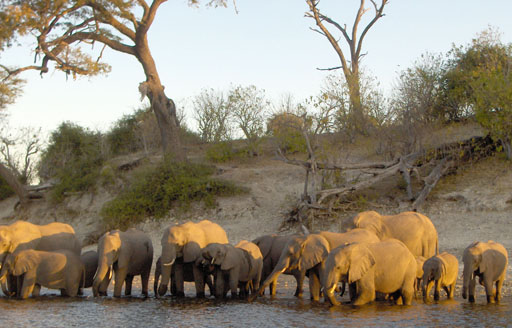
We saw the biggest herds from the Chobe river next to the Chobe National Park, near Kasane.
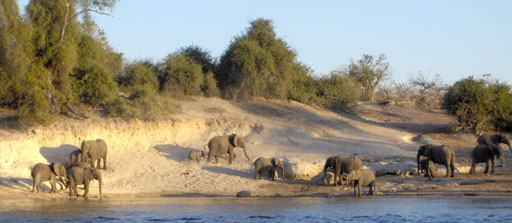
There are 50,000 elephants in the 11,700km² park, and in the dry season, many of the ones in the north go to the river in the late afternoon to drink. There are so many elephants there that there are practically traffic jams!
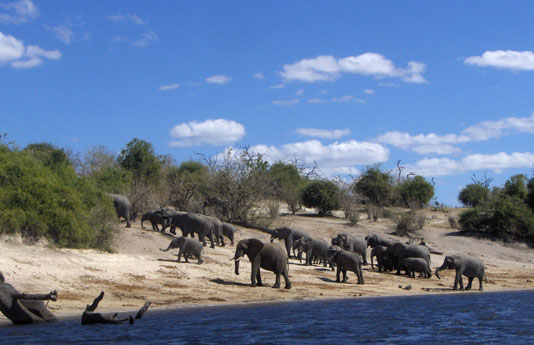
Not only that, but the herds do not run away from tourists in boats. I don’t know if they are just habituated to tourists and how much of it is that groups of primate predators in boats aren’t as threatening as groups of primate predators on land. (How do they know we are predators? Predators have eyes that face forwards.) The elephants kept wary eyes on the boats, but they weren’t spooked enough to move away. Later on the safari, we mostly got to watch animals’ backsides as they moved away from the scary tourists; the river cruise was one place where we saw their frontsides.
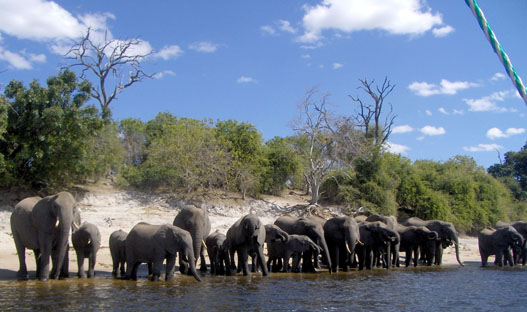
In the same way, because we were in boats, the elephants weren’t a threat to us. That meant that the boat captains could bring us quite close. I estimate that we got to within four or five meters of elephants (and crocodiles and hippos!) sometimes.
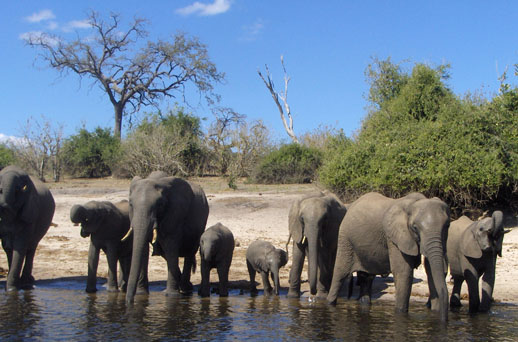
On our second river cruise, a bachelor herd (males only) swam across the river RIGHT IN FRONT OF US. I knew that elephants could swim, but was quite surprised at how they swam. Unlike dogs or horses, their heads are almost completely submerged and their bodies are completely invisible. All you can see is a little bit of trunk, acting as a snorkel, and the tops of their heads. Their heads rock forwards and back as they swim.
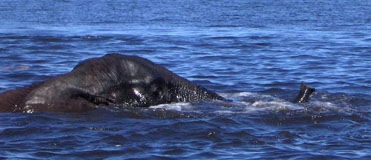
Elephant swimming across Chobe river
All fourteen of the bachelor herd got into the water, but one young male turned abruptly back after walking in up to about his shoulders. Our guide surmised that he was new to the area and afraid of the water. As we left, he was wandering back and forth on the shore, looking across the river at his buddies. I imagined him feeling bereft and forelorn, hating being separated from his herd but also afraid of the dark waters in front of him.
His buddies, once they got across, pulled up hunks of the tall grass in the marshy land on the other side and for all the world appeared to spank the ground with it, then eat it. Our captain explained that they were knocking the dirt off of the roots. (They maybe were standing in a little bit of water — hard to tell from a distance when marsh grasses were everywhere.) When an elephant dies of “old age”, it is usually from starvation. Either the teeth wear down to unusable or they fall out, and then the elephant can’t chew its food adequately. If they knock the dirt off, then that saves wear and tear on the teeth.
On the other hand, sometimes elephants would eat dirt. Yes, really. There are some minerals (like salt) that aren’t plentiful enough in their food, so they will dig holes and eat the dirt. (They might not chew the dirt, I suppose, so perhaps that dirt doesn’t wear down their teeth.)
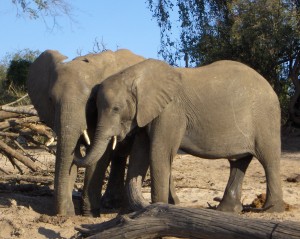
Elephants feeding each other dirt from a hole they dug
The first pictures, of the elephants at the riverbank, are mostly “breeding herds” — composed of females and juvenile males. As soon as a male starts getting overly friendly with the females in the herd, the mother forces him out! I sure hope that elephants have complex language, as otherwise it seems like it would be a horrible, horrible shock. Imagine being a boy who spends every minute of every day with the same twenty family members, and as soon as your mom sees you checking a girl out, she forcibly runs you out without telling you why! Imagine then having to find a group of other lonely males — with presumably a different social structure — and try to fit in.
The bachelor herds we saw had a range of ages hanging out together. We heard that the younger bulls learned how to do things from the older bulls. (Presumably like how to cross rivers, and also where the good water holes are.)
Bulls do not always hang out together; sometimes they go off on their own. Not being an elephant psychologist, I don’t know if they are socially maladept, bored, tired of being around younger bulls, tired of being around older bulls, or what. Maybe those anthropomorphic emotions don’t even make sense for elephants.
We did observe two elephants being affectionate (or at least intimate) with each other, feeding each other dirt from a hole they had dug — see photo above.
It was not uncommon to see lone bulls — occasionally at very close range!
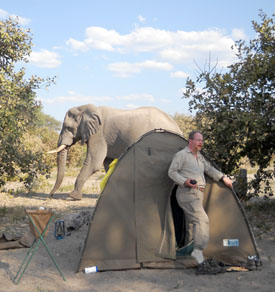
Jim responding to cries that there was an elephant in our camp
We were taking a siesta in our tent when we heard people shouting that there was an elephant in our camp. We weren’t sure if we were safer inside the tent our outside, and eventually chose to get out of the tent, only to discover that the elephant was only five meters away!
This bull was after seed pods from the camelthorn acacia tree in our camp. He put his tusks around the tree, carefully laid his trunk up the tree trunk, and shook the tree, making pods rain down. He hoovered the area of pods and then sauntered off, totally nonchalant and disinterested in us.
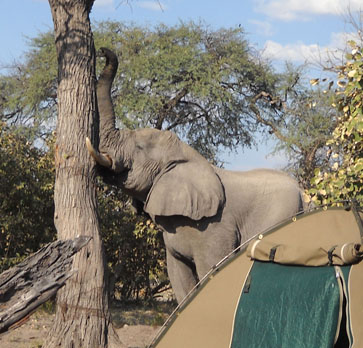
Bull elephant harvesting camelthorn acacia seed pods
I was surprised at just how quiet elephants are when they walk. As I mentioned above, the elephant in our camp was 5m away and we never heard him. Not a thing. They are so big that you’d expect the ground to shake as well, sort of like a truck going by, but no, not a thing. When walking, they have three feet on the ground at any one time, and have big poufy feet, so they are incredibly stealthy. Here’s how big their feet are compared to mine:
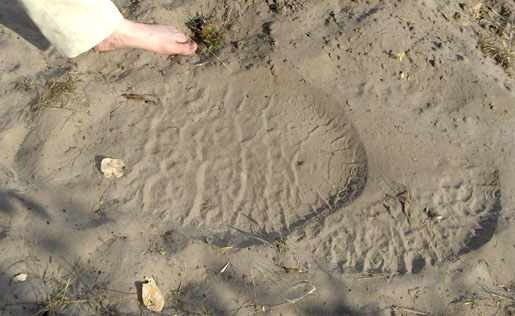
Tracks of the elephant that went through our camp
Later on the trip, Jim and I heard a great deal of splashing around while we were visiting the camp latrine, which that night only had distance as its privacy guard. The splashing noise went away before we finished up, and on our way back we encountered a (very uncomfortable/embarrassed) guide who wanted to warn us that an elephant had swum across the river and landed right near us, but didn’t really want to intrude upon us in the latrine! Once the elephant got out of the river, we heard nothing, even though the splashing sounded quite near.
Did that frighten us? No. Maybe it should have, but it didn’t. The elephant that passed the latrine could probably smell us (and the latrine), we were not advancing upon it, it would have to go through some bushes to get to us, and elephants are usually not aggressive unless they are in musth (a condition similar to erustrus in females, characterized by extreme randiness, aggression, and a strong and distinctive odor) and we didn’t smell anything funny. We also only heard one animal splashing, which meant that it was unlikely to think we were threatening its child.
We did see adult females protecting a baby elephant quite fiercely a few days before: note that there are four adult females forming a defensive ring around the baby, barely visible (cyan arrow points to its tail). They were also trumpeting and flapping their ears.
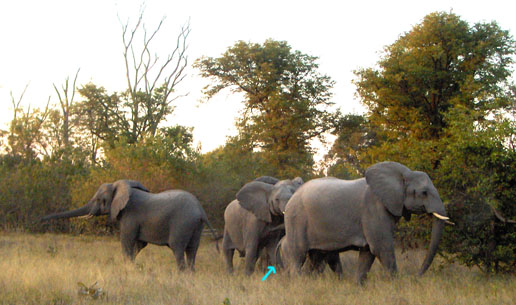
Four female adults protecting one baby elephant
While elephants’ walking is nearly silent, the same cannot be said for their crapping. Their dung comes out in volleyball-sized balls, and like horses but unlike dogs (or lions, as we observed later), elephants don’t stop and squat to defecate, but just lift their tails and keep on walking. That means their dung falls from a great height — two or three meters up. Boom! Boom! Boom!

Elephant dung
The shape is such that, well, I will never look at Rolo chocolates the same way again.
On our river cruise, we were quite surprised to see baboons apparently eating elephant dung. Our guide explained that elephants have poor digestive systems. (Elephants pass so much fiber in their dung that people make paper out of it!). Their digestive system is so poor that frequently it lets fruit and nuts escape undigested. Baboons would thus root through the elephant dung in order to find those fruits and/or nuts.
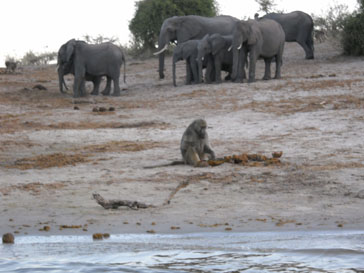
Baboon eating elephant dung
As you can see, I was fascinated by the elephants.
Permalink
Posted in Family, Travel at 5:42 pm by ducky
Jim and I, having no kids of our own, borrow nieces and nephews when they turn (about) fourteen. We had a friend from Botswana who encouraged us to visit, and The Niece was up for it, so we went to Africa! This post talks a little about where we went, how we got there, where we stayed, what the accommodations were like, etc. This post will have almost no observation/analysis/personal notes: it probably isn’t that interesting unless you really like Jim and/or I, or you are planning/thinking about a trip to Botswana yourself. (See the next postings for analysis and personal notes.)
We spent twenty-four days total away from our home, although we spent about seven days getting there and back: one day from Vancouver to Seattle (via Bellingham to pick up The Niece), one night to Frankfurt, one day in Frankfurt, one night to Johannesburg, one day drive to Botswana, and then the reverse (except we flew to Jo’burg instead of driving).
The Safari
The centerpiece of the trip was a seven-night/eight day overland (i.e. driving) safari with Chobezi, camping for one or two nights in one place, then driving to the next interesting place. We travelled in a group of eight: us three, two Belgian men in their early twenties, one guide/driver, and one cook.
We found and booked the trip online (and when I say “we”, I mean “Jim”), with what turned out to be a South African booking agency. This meant that we knew very little about what the safari would be like. We knew where we would be stopping, and we knew that we were going overland and camping in tents with foam matresses, but that was all we knew. We knew so little that we even had trouble rendezvousing with Chobezi at the pickup point!
We camped at four places: at Serondela and Savute Marshe in the Chobe National Park, Moremi Game Reserve, and an island in the Okavongo Delta.
A typical “moving” day would have us get up around 0630h, eat breakfast, pack our gear, tents, and sleeping rolls, wait for the guide and cook to pack everything else (they turned down help), and drive to the next site, looking for game along the way. We’d set up our tents and bedrolls, then take a siesta, sunbathe, hang out, whatever, until about 1630h, when we’d do an evening game drive before dinner. A non-“moving” day would be the same except that we’d go for a game drive early in the morning and not tear down/set up camp or drive to the next site.
We rode around in a “safari car” or “safari truck” — a converted Land Cruiser with elevated bench seats. The truck we used on our safari has five seats plus some storage in the back, plus it hauled a trailer full of stuff when we moved camp. I believe most safaris rely more heavily on airplanes to get people from one place to another; I don’t recall seeing another safari car with storage.

Our safari car
Here are some other safari cars:
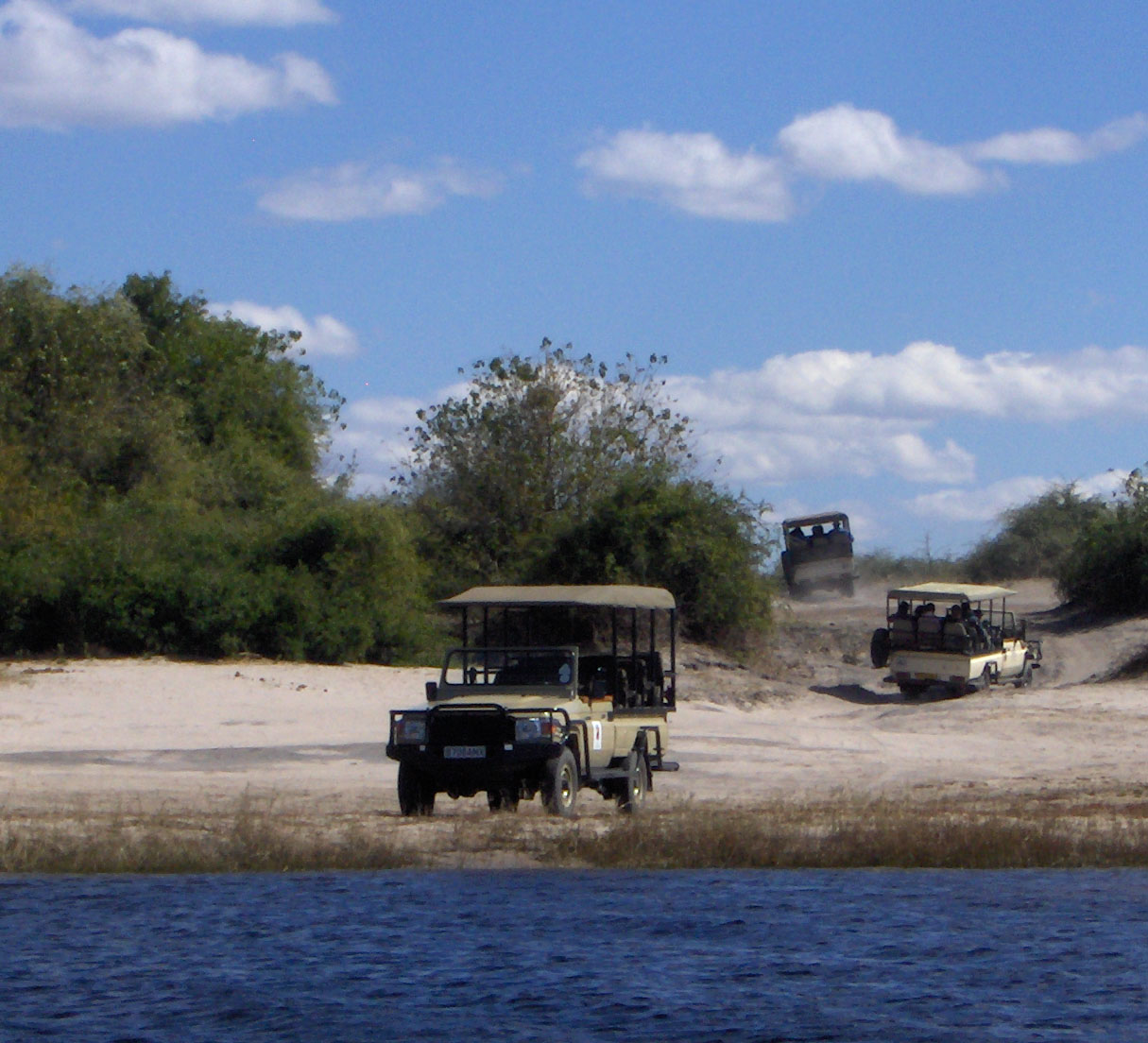
Some other companies' safari trucks
The tents were quite big. The Niece and I could stand up in them.

Ducky Standing up in tent
I had never seen bedrolls these before: they were relatively thick foam matresses, with sheets, pillow, and a comforter placed on them, that we could zip up and roll up.

Bedrolls unfurlled (L) and in bondage (R)
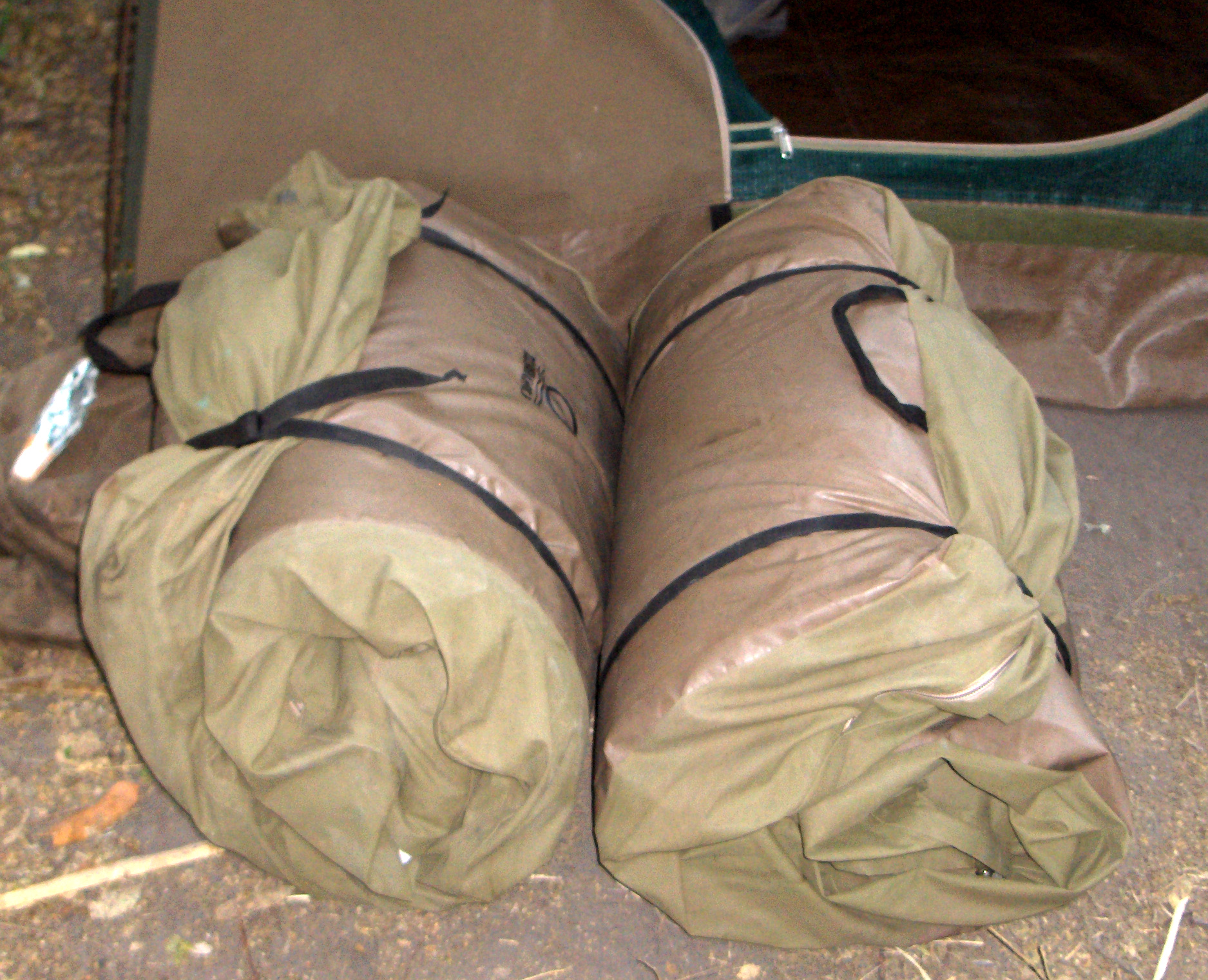
Bedrolls rolled up
The tents and bedrolls were heavy, but because we were car camping, it didn’t matter.
Camp hygiene
The camp had a it latrine with a toilet seat frame over it, and canvas walls set up around it. Jim once commented that in terms of value per ounce, the toilet seat was way, way up there!
Next to our tents they put little canvas bags that served as wash basins. Every morning, they would put hot water in the basins for us to wash with. That was really nice!
We also didn’t realize it until near the end, but we had a shower available as well. Apparently the first day, our guide asked me if I wanted a shower. “Maybe later”, I said, and he waited for me but I never got around to asking. I don’t remember this: probably I thought he was kidding. (A shower? While camping?)
At our second stop (at Savute Marsh), we stayed in a campground, with hot showers and sinks and flush toilets and everything. They also had neat washbasins with built-in washboards, so clearly you were allowed (encouraged?) to wash your laundry in the sink.
There were probably twenty campsites at the Savute Marsh campground, filled mostly with self-driving South Africans. You would think that would impede the wildlife viewing, but in fact did not, as you will read about in my elephants post.
Camp food/cooking
Cooking was done on an open fire. They brought along something that looked like an iron coffee table, and put that over the fire.
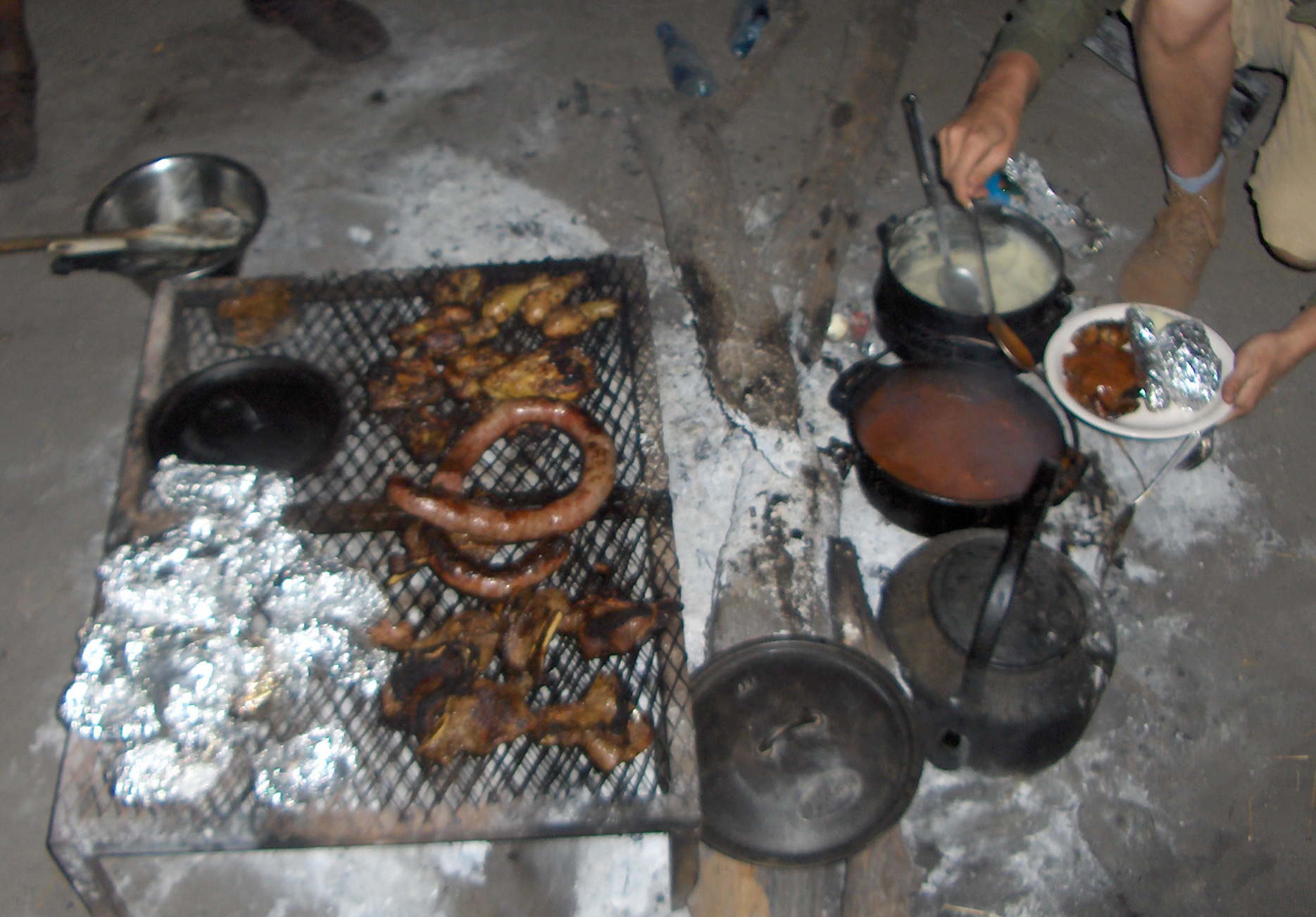
Kitchen facilities
Breakfast consisted of cold cereal, tea, porridge (oatmeal), and fruit. On moving days, lunch was usually sandwiches (cold cuts), potato salad, and fruit. Dinner was always a hot meal, with a meat course, starch (potatos, rice, or “pap” — sort of corn/maize porridge), and a vegetable dish (e.g. carrots and potatos). The food was really, really yummy — the cook did a great job.
Jim and I normally try to eat vegetarian, with Jim being better at sticking to his values than I. I wimped out and ate the meat in Botswana because it was just easier. (Jim had told the South African booking company that we were vegetarians, but that piece of information never got to the guides.) Jim just didn’t eat the meat for a few days. The cook and guide noticed, and asked Jim, who said that he preferred to not eat meat.
The next day, the cook announced that “for the man who does not eat meat, I fixed something special.” With a flourish, he revealed… chicken! (In many languages, “meat” means “mammal meat”.) Faced with that level of attentiveness and care to his needs, Jim (sigh) ate the chicken.
Mokoro camp
For our last two days, we said goodbye to our driver (although we kept our cook) and went out to an island in the Okavango Delta by boat(s). First we took a speedboat to the Boro village, where we transferred to mokoros — poled dugout canoes — for a two-hour water voyage to our camp.
Getting ferried by what are essentially African gondolas sounds very romantic. The reality was less so. The boats were very tippy, so you had to be careful about shifting around. The seats were basically institutional plastic chairs with no legs, just dropped into the boat, so weren’t that comfortable. We went there in the afternoon and came back in the morning — and the camp was west, so we had the sun in our eyes both times. Perhaps because it has been an extremely wet year, there were thousands of gnats, which hovered right at sitting-person-level. To catch the gnats, many water spiders built webs right at sitting-person-level. (Note: neither the gnats nor the spiders bit. They were just annoying.)
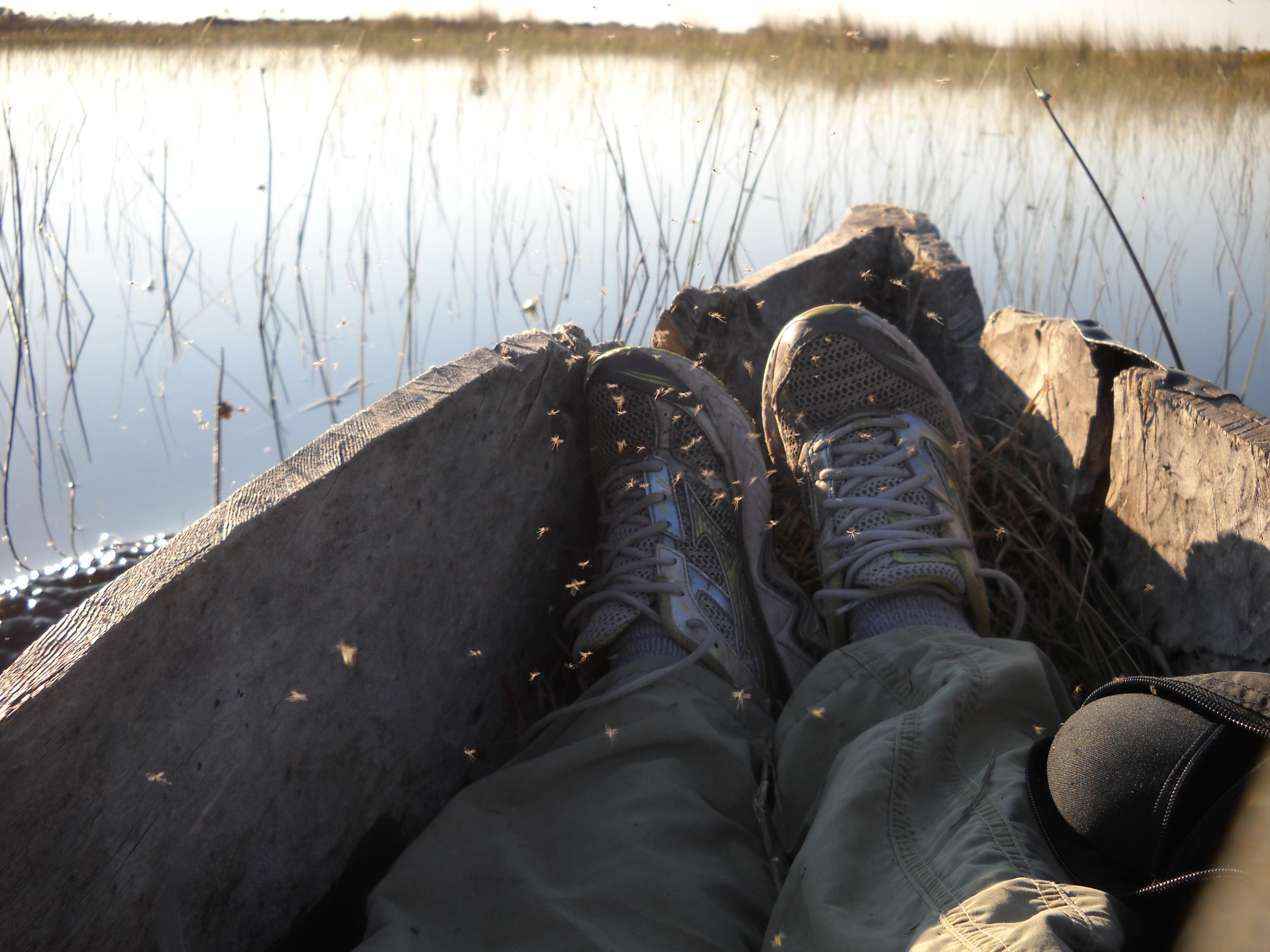
Gnats during Mokoro ride
One of the Belgian youths turned his seat around so that the back of his head caught the gnats and spiders, and the sun was not in his eyes. That would have been much more pleasant. Going out in the morning and back in the afternoon would have also been more pleasant.
We went on a game walk on the island, something that we couldn’t do elsewhere. In other areas, we had been pretty much stapled to the truck because of the small but real danger from lions. While we did get a safety lecture before our walk on what to do if we encountered lions, hippos, snakes, or wildebeests, I presume that the dangerous animals are rare on that island. (We did not see any lions, hippos, or snakes, and the wildebeest were a long way away.)
It was nice to get some exercise, and we saw larger herds of animals than we did from the safari truck. (The truck is noisy. It can’t really sneak up on a herd the way we could on foot.) However, we couldn’t get as close on foot, in part because of the need to be stealthy, in part for safety reasons. While we saw lions from several meters (and in one case, ONE meter, see below) from the truck, on the walk we were usually more like 500m or 100m from herbivores.

One example of how close we got in the truck
We also didn’t see much on the walk that we hadn’t already seen from the truck, aside from an aardvark den (a hole in the sand).
The locals who guided or poled us to the island did sing and dance for us on the second night, and we got a mini-tour of their village, and that part was nice. Aside from that, however, I could have done without the Okavongo Delta part of the tour.
Non-safari
We spent several days in Gaborone (“Gabs”), the capital. We ran out to tour the diamond mine in Jwaneng the day after we landed (since the mine only gives tours on Fridays). The mine could have been any heavy equipment plant in North America, except that the second language was Setswana and not Spanish (US) or French (Canada) and there were two more baboons than I would have expected in North America.
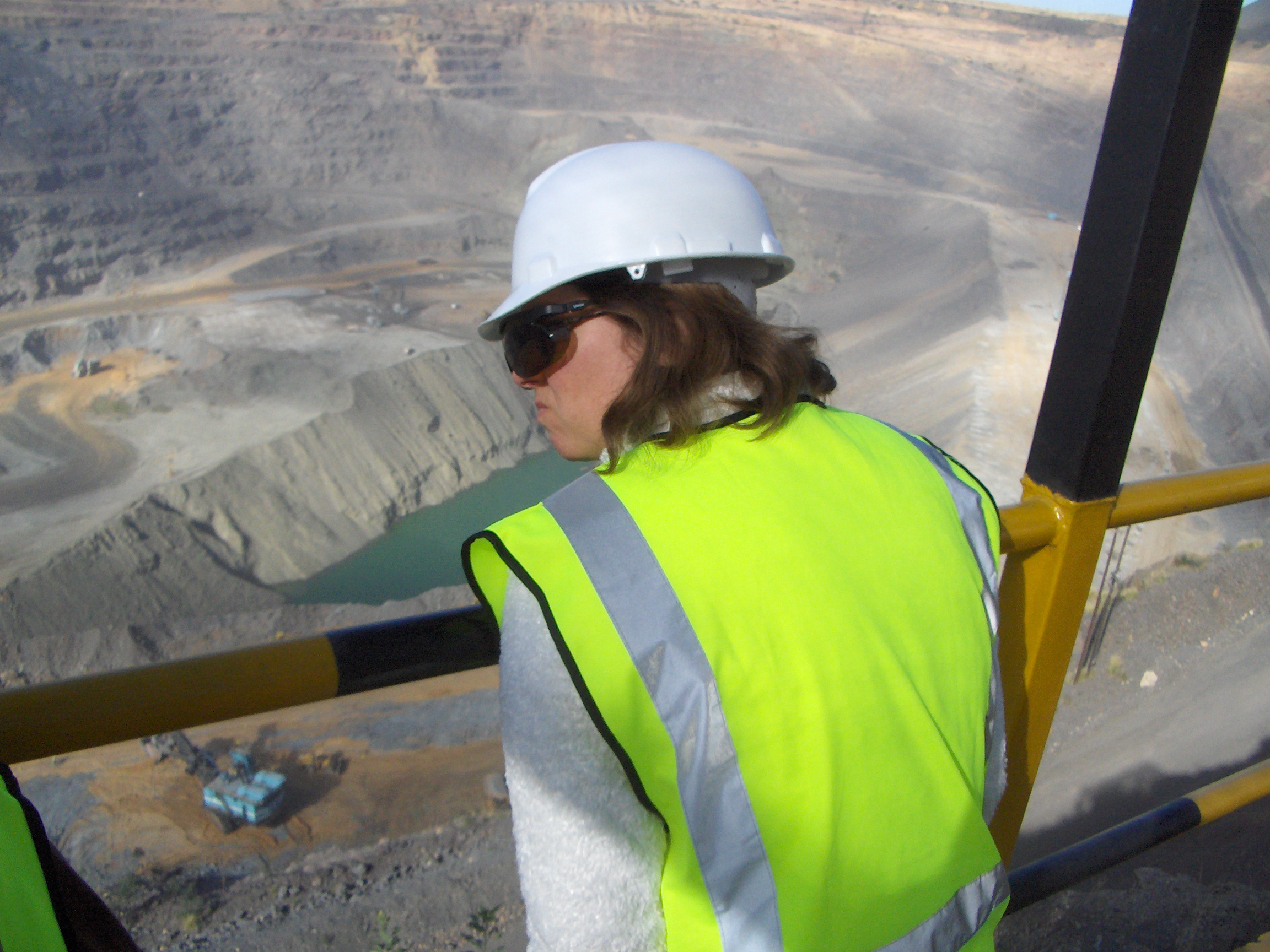
Ducky looking out over open-pit diamond mine
We spent the weekend wandering around Gaborone — checking email, letting Katie run on a treadmill at a gym, shopping for things the airlines ban, buying local GSM chips for our cell phones, trying and failing to find local maps, wandering around shopping malls and bazaars — and waiting for our friend B. We were supposed to leave Gabs on Sunday, but our friend B. sadly had to go to a funeral on Sunday, so we had an extra day in Gabs.
We were going to go to the Khama Rhino Sanctuary in Serowe, but because of the funeral, we had to cut something, so we cut the rhinos. We found out later that our friend B. is from Serowe; had we realized that, we would have cut something else.
Serowe is also the hometown of Sir Seretse Khama, the first president of Botswana. Botswana is, unlike its neighbours, a bastion of peace and (relative) prosperity, in large part due to this one amazing man. Please pause now and read his Wikipedia entry before going on to my next Africa journal blog posting.
Permalink
11.05.08
Posted in Canadian life, Family, Politics at 1:45 pm by ducky
Several people have asked me, “So are you and Jim moving back to California now?”
The answer is “No, not yet. Maybe never.”
I had six reasons to move to Canada:
- I was devastated that my fellow Americans could elect G.W. Bush for a second term. That said to me that my fellow Americans and I were not at all on the same page, and that maybe I didn’t belong in the US.
- I was upset at how my government shredded civil liberties for both citizens (e.g., illegal wiretapping) and non-citizens (e.g., torture and abuse).
- I was unnerved by an almost willful neglect/disinterest in some major, fundamental structural problems in the US and Californian economies. In particular, the US has been, as Lloyd Bentsen famously put it in a 1988 VP debate, been “writing hot checks” for a very long time: spending a lot but not paying enough in taxes to support those costs.
- UBC was more nurturing than Stanford, my other choice for grad school.
- We have lots of relatives close to Vancouver, just across the border in Bellingham.
- Canada’s health system is not tied to employment. It is highly likely that we will, at some point, earning money but not be employed. Living in Canada, that’s not a problem. (Like right now. I’m looking for work and Jim is consulting.) Living in the US, that might be a problem.
The fact that my compatriots turned out in such droves for Obama lessens the feeling that I am out of step with the rest of America. I was shocked and appalled by the divisive tactics used by the McCain/Palin campaign, but enormously heartened at the number of Republicans who have publicly voiced being likewise shocked and appalled. So Obama’s election knocks off #1 pretty well.
I have finished my graduate degree, so #4 is off the list.
Our families are still in Bellingham. We could move to Seattle and be slightly closer to our families, but California would be quite a bit farther away. So #5 favours Vancouver or Seattle, but still disfavours California.
I think Obama will probably make #2 better. Issuing an executive order banning torture at one minute past noon on Jan 20, 2009 would be a good start, but to see how he does on #2, I’ll have to see him govern.
Likewise, on #3, I won’t know if he will make things better until I see him govern. However, it’s not likely that he will be able to avoid “hot checks” in his term because of the horrible horrible financial problems. He also can’t do much about California’s problems due to Prop 13.
There are more factors to consider now.
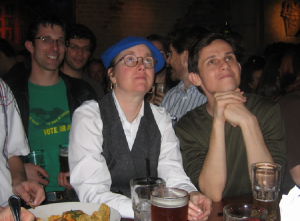
Ducky Watching Election Returns
- I like many things about Canada and Vancouver.
- I have friends here. (It was really nice to watch the election last night surrounded by a bunch of friends!)
- It is really cool to live in the heart of downtown. We are able to walk to everything (so much so that we only use our car about twice per month).
- I like, in theory, that there is skiing so close. We have season passes this year to a mountain that we can see from our apartment. It takes about 30 minutes to drive there.
- By and large, Canadian government services have far better customer service than in California. It takes me about twenty minutes to renew my Social Insurance Number (like a Social Security Number in the US). It took me about fifteen minutes to move my driver’s license to BC.
- It is not a perfect fit.
- In particular, I still have ambitions to change the world, while I think Vancouver puts more value on having fun. I’m trying to get the “fun” attitude, but it’s swimming upstream for me. (Hopefully the ski passes this winter will help!) Silicon Valley is all about changing the world, and so that is a huge magnet attracting me south.
- I don’t like maple syrup, I have never played hockey, and I thought Anne of Green Gables was a boring book. I did not spend many years steeped in the Canadian cultural stew, absorbing the Canadian value system, shared experiences, and etiquette. I will never be fully Canadian. (At the same time, the longer I stay in Canada, the less time I spend in the American cultural stew; the less American I become.)
- Somewhat to my surprise, I discovered that I still love my country.
- I am growing to love Canada.
- I haven’t found a job yet.
So. Will I return to the ever return to the US? To California? I’m not sure.
Permalink
05.10.08
Posted in Family, Hacking, Random thoughts at 9:38 am by ducky
My husband and I are geeks. This manifests itself in many ways. One way is that when we moved up to Canada from Palo Alto, we numbered all of the boxes and logged all of the contents of all of the boxes.
In anticipation of our move to a tiny tiny apartment in downtown Vancouver, I packed up a box of books and class notes to take down to our storage locker in the US. Jim said that he’d been assigning new boxes numbers in the 200 series — 200, 201, etc.
Me: “Jim, would you be a name service for box numbers?”
He pulled out his PDA and got ready.
Me: “Um, ‘Hello.'”
Jim said nothing but was suppressing a grin. He continued to say nothing.
Me: “Doh! Right! Carriage-return, carriage-return!”
Much laughter ensued. We are such geeks. 🙂
(When taking DIRECTLY to Web servers, i.e. not through a Web browser, you have to issue a command like “GET / HTTP/1.0” and follow it with *two* carriage returns. One won’t do, and it’s a really easy mistake to make.)
(PS, Yes, I know that HELOs (used in email protocols) don’t need two carriage returns.)
(PPS, Yes, I know that technically it’s CRLF, CRLF, not CR, CR.)
Permalink
02.15.07
Posted in Family, Married life at 11:34 am by ducky
Before nephew Yeshe came to live with us for year, my husband and I talked a bit about getting his buy-in on how the family should run. Being Silicon Valley corporate geeks, we wrote a mission statement for our family:
Family is a happy place where everyone works together to help each other achieve their goals.
Yeshe came and went, but the mission statement lives on. I really like it, and am really glad we sat down and wrote it out.
Permalink
11.18.06
Posted in Family at 11:29 pm by ducky

My cousin-in-law — my husband’s cousin’s wife — died last night. She had been in remission from breast cancer for about three years, but it came back.
This picture is from our wedding reception. She brought bubbles and blew them and it was just perfect.
There is breast cancer drug that is currently being fast-tracked that works wonders on certain types of breast cancer. I keep thinking that if only she could have hung on for one more year — maybe even just six more months — maybe she could have gotten through it. I suppose that there are always what-ifs: one of my ancestors died of an infection he got from cutting himself with an ax, an infection that antibiotics would have made a non-issue.
Still, why her? Ellen was a wonderful, sunny person. Every time I saw her — including two and a half months ago — she had a big ol’ grin on her face, radiating joy. Why couldn’t it have been some jerk like Mugabe?
I — and all of her large extended family — will miss her.
Permalink








































